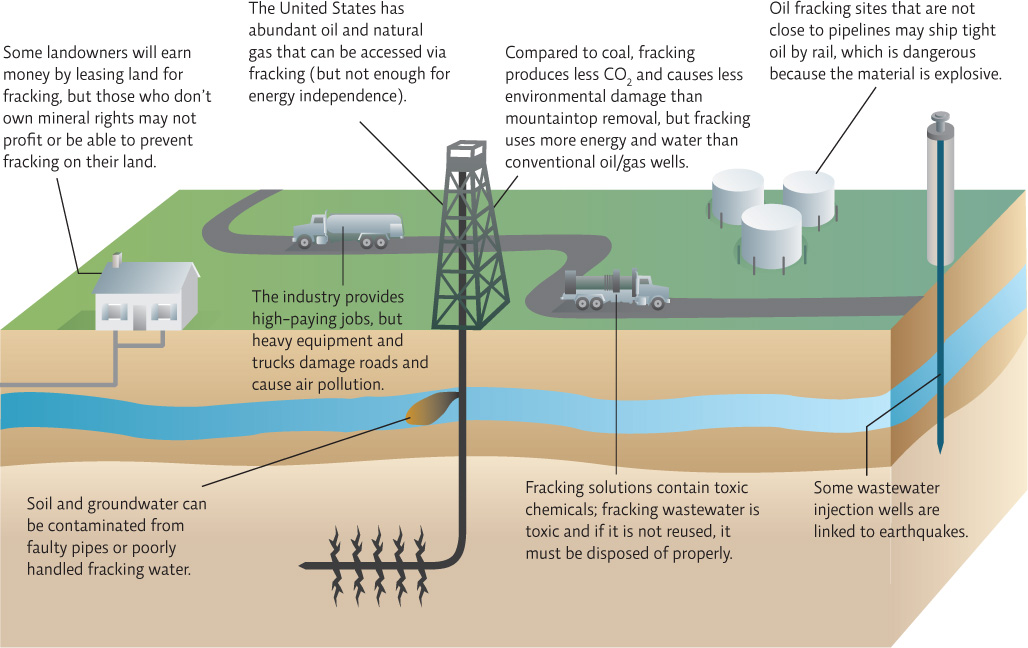Is fracking the answer to our energy needs?
It’s tempting to think of the oil made available by fracking technology as infinite, or at least plentiful enough that we can stop worrying about peak oil and energy independence for the next several lifetimes. The numbers, after all, are mind-boggling: We have more than 700 billion barrels of tight oil in the Bakken, Eagle Ford, and other known reserves—and that’s just in the United States.
energy independence
Meeting all of one’s energy needs without importing any energy.
KEY CONCEPT 19.8
Fracking has positive economic impacts, but negative environmental and social impacts make it contentious.
But, of course, just a tiny fraction of those totals is actually recoverable—somewhere between 1% and 2% in the Bakken and Eagle Ford shales, or between 7 and 14 billion barrels. “At the high end of the estimates, predicted production from Bakken and Eagle Ford together amounts to perhaps a two year oil supply for the United States at 2011 consumption rates,” says Raymond T. Pierrehumbert, a professor and geophysicist at the University of Chicago. “That’s significant, but not a game changer.”

Because fracking wells can access only a small part of the oil deposit that surrounds them, many, many wells are needed to tap an entire deposit. This diminishes the EROEI because creating each new well requires an expenditure of energy. In addition, the productivity of any given well is likely to drop off rapidly after the first couple years and then trail off into nothing, slowly, over decades.
“Technological developments have made it possible to tap into tight oil,” says Pierrehumbert. “But these are not the same kinds of technological developments that have given us ever more powerful computers and cellphones at ever declining prices. Oil production technology is giving us ever more expensive oil with ever diminishing returns for the ever increasing effort that needs to be invested.”
Indeed, experts have begun to suggest that the Bakken oil fields may already be close to, if not slightly past, their peak. More and more wells are being drilled each year, and they are yielding less and less oil overall. “Tight oil is headed for a Red Queen’s Race,” says Pierrehumbert. “You have to keep drilling and drilling and drilling just to keep your production in the same place.” INFOGRAPHIC 19.9
Fracking for oil and gas in shale deposits can allow us to extract large amounts of oil and natural gas, extending supplies and reducing our dependence on imports. But several trade-offs that must be considered when determining whether or how best to proceed with fracking.


The negative impacts of fracking are listed here. What are the advantages to the United States of fracking for unconventional sources of oil and natural gas? Do the advantages outweigh the disadvantages?
Fracking operations provide jobs and money for local economies. The United States has abundant supplies of tight oil and shale gas that can extend overall supplies by a decade or more and could displace some coal (a more environmentally damaging fossil fuel to burn and extract). By increasing domestic supplies, we decrease the amount that must be imported; this decreases our dependence on imports from politically unstable countries and even serves as a potential export, helping to reduce the U.S. trade deficit. Whether the advantages outweigh the disadvantages depends on the weight assigned to each. If short-term, financial gain and political stability is deemed the most important factor, then fracking might be seen as a reasonable pursuit. If long-term concerns about environmental damage or long-term energy supplies are deemed most important, then other options might seem like better avenues to pursue.